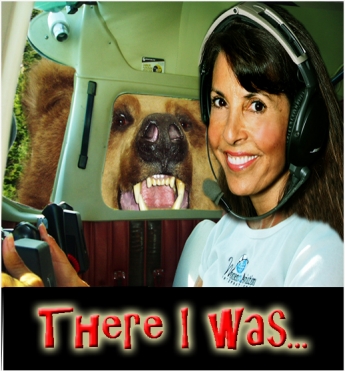SkyChick Adventures
By Ramona Cox
Nothing fulfills a pilot's thirst for adventure better than remote air-camping.
Landing on airstrips located deep in the wilderness with an inflatable kayak and fishing gear simply epitomizes the word wanderlust.
When the airstrip is short, high elevation, overgrown with grass and ruts with density altitude numbers approaching five digits, you're not striving for a greaser. A few small bounces and no major damage is more than satisfactory.
Some pilots worry about violating the latest TFR's. My concerns focus around the suicidal moose who casually
strolls in front of my landing aircraft. One thousand pounds of muscle mass is similar to hitting a brick wall which can easily pierce and crumple the thin skin of my fragile fuselage or wing.
Then there are the pesky little gophers that work like stealth saboteurs digging camouflaged holes in the tall grass that can swallow my nosewheel and leave me stranded in the middle of nowheresville. Landing is one thing.
Actually getting to the tie-down spot safely requires additional skill similar to that of a soldier who is carefully maneuvering their way through a mine field. The best airstrips are surrounded by true wilderness with the nearest road access at least 50 miles away. In other words, you can't call 911, there is nowhere to run, and a scream would do nothing more than echo through the canyons.
Given those parameters, every sound, no matter how slight, gets your attention. Without the noise of towns, cars or any form of civilization, your hearing becomes much more acute, particularly at night.
And when deer run out of the woods looking back in despair, you can't help but wonder what's chasing them?
In the evenings, I prefer to be sitting outside of the tent with my back against the side of the fuselage or prop. My eyes slowly adjust to the ominous blackness.
Although I can't see deep into the woods, the runway provides a vast open space whereby I can often see the silhouette of creatures lurking in the distance. Is it a deer, moose, bear or perhaps a mountain lion?
Sometimes they're close enough for my flashlight to turn their eyes into glowing green marbles. This helps me determine their height and girth and choose the most appropriate weapon for my uninvited guest.
I've learned to always be prepared even if the locals say that there are no predators. Wild animals and some humans are unpredictable. Before sleeping, I move my bed from the side of the tent to the middle.
Little things like that matter when you consider that the intrusion may start with the long razor-sharp claws of a grizzly bear slicing through the tent like a knife into butter. Although I've read virtually every book on bear behavior, I still haven't figured out how to tell the difference between a "bluff charge" and the real deal. Then there's the tricky matter of guessing whether the approaching bear is the type that bats you around but eventually leaves if you play dead or if it's the type that casually gnaws on you until you are so weak that playing dead becomes a reality.
Then, let's not forget the aggressive moose with the temperament of a hungry pit bull that will run you down and stomp you into a pulp if you make the grave mistake of getting between she and her calf. At least bear and moose usually give a warning. What keeps me on edge is the stalking mountain lion that silently sneaks up and gives NO warning before making his lethal lunge.
Sound good so far?
If you're a true adventurer, these words have you salivating with anticipation. Right about now you're checking your calendar for the next opportunity to get out of town and fulfill that deep rooted desire to become one with nature.
What is it that draws some of us to the wild like bees to honey? I wish I knew but its summer and I can feel of beckoning of glassy lakes with hungry trout, smell the sweet aroma of pine trees and relish in the thought of exploring more of magnificent back-country.

